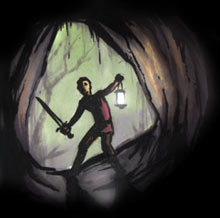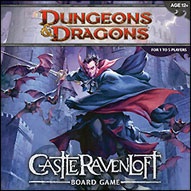
|
About OgreCave and its staff
|

|
by Demian Katz
This game is featured in the OgreCave Christmas Gift Guide 2010. The Castle Ravenloft board game was one of the most anticipated releases of the summer. This is not surprising; Ravenloft is one of the most enduring Dungeons & Dragons properties, and resurrecting it as a cooperative board game was a stroke of brilliance, since it captures both the board-gaming and role-playing audiences. The fact that the game is presented as a gigantic box full of goodies probably didn't hurt the excitement factor in the weeks leading up to its release! Hype is a dangerous thing, as it often leads to disappointment; however, now that I have a copy of this game in my hands, I have to say that I am not disappointed.
Inside the Box It's a fairly good haul for the price tag, and there are only a few minor ways in which you might be disappointed. The miniatures are unpainted, and are recycled molds from the D&D Miniatures line (I recognized the skeletons from the old third edition starter set). I prefer to paint my own miniatures, and the recycled designs are good ones, so this doesn't bother me. The dungeon tiles interlock using a puzzle piece mechanism, which is great for keeping the board together during play but which limits their suitability for reuse in a separate D&D campaign. The full range of polyhedral dice is not used here, which may upset the dice-lovers in the audience. Fortunately, none of these potential complaints does anything to diminish the fun of the game itself! The Basics Of course, at the start of the game, there is nothing to attack yet. That changes quickly! Every time a player ends their turn on an "unexplored edge" of a tile, they attach a new tile to the board and draw a monster card. Every tile has an arrow on it which shows how it must attach to the existing layout. Tiles are also equipped with bone piles which show where new monsters come into play. After adding the tile to the layout, the player finds the appropriate monster miniature and puts it in place. The player also holds onto the monster card: this will be important later. After exploration comes the encounter phase. If the active player explored a new tile, and the tile happened to feature a white arrow, all is well – nothing happens. However, if no new tile was explored, or if the new tile featured a black arrow, an encounter card must be drawn. These are never good – either a new hostile environment comes into play, or a trap is set off, or extra monsters appear, or something arbitrary and horrible happens to somebody. The encounter cards really help drive the game forward – you don't want to waste time in Castle Ravenloft, because standing around in a seemingly safe area is just as good a way to get yourself killed as charging into battle. Once the encounter has been resolved, the monsters get their turn. Every player is responsible for resolving the actions of the monsters that he or she drew. This means that players almost always get immediately attacked by the monsters they discover during exploration. It also means that, depending on the number of players in the game, you may have a few turns to kill a monster before it strikes again. There is one critical exception: if two players hold the same monster card, BOTH monsters of that type attack on BOTH players' turns. You really don't want to end up in a dungeon full of gargoyles – it's not a pretty thing. There is one minor detail of this rule for which players should be grateful: no player can have more than one of the same monster card, so there is at least some limit on how far the odds can be stacked against you. When activated, each monster card provides simple tactics that must be followed – usually something along the lines of "attack the adjacent hero if there is one; otherwise, move one tile closer to the nearest hero." When attacking, monsters operate just like heroes, rolling a d20, adding a bonus, and comparing the result to their target's Armor Class. Some monsters also have special abilities that need to be remembered during the course of play – the wraith, for example, unleashes a deadly scream when killed, damaging anyone unlucky enough to share its tile at this point. There are a few ways in which monsters are not all bad. First of all, when you kill them, you get treasure cards, which provide not just physical treasures but also intangibles like healing and recovery of used powers. Additionally, monster cards are worth experience points. The players stack defeated monsters into a shared experience pool, and experience points may be spent five at a time to prevent unwanted encounters from occurring. Experience can also be used to level up; if a player rolls a natural 20 during combat, he or she may immediately spend five experience points to level up, thus flipping over their character card to reveal more hit points, better armor class and the right to add new power cards. Sure, it's not much like regular D&D, but it works well enough in the context of a board game. Not surprisingly, Castle Ravenloft provides ample opportunity for the players to lose. If any single character dies, the whole team loses the game. Players do have a small, shared pool of healing surges which can be used to save a character who has run out of hit points, but these are exhausted quickly. While there are many ways to die, there is generally only one way to win... and this varies from game to game. The Adventures Each adventure provides its own special setup and victory conditions. While all of the adventures use the same core dungeon tiles and card decks, each adventure adds its own unique twists: special items from the "adventure treasure" deck, an increasingly powerful series of villains, new meanings of specific room tiles in the stack, or special counters with their own rules. Considering that each adventure may well take you a few tries to defeat, there is a lot of gameplay packed into this box. It will be quite a while before you can say that you have seen everything this game has to offer... and by then, there's a good chance that the follow-up game (Wrath of Ashardalon) will be out, offering a whole new set of possibilities. The only thing I'm a little disappointed about is that the adventures don't all link together into a single huge campaign. While the adventures build upon each other by providing challenges of increasing difficulty, for the most part, they are designed to stand alone. The only direct connection between two scenarios I have seen is that one of the free online adventures allows you to hook into one of the other adventures from the box with a bonus item if you succeed. Characters can't advance past level 2, so there isn't the sense of long-term advancement that you get from Dungeons & Dragons. Available powers are fairly limited, so you may find yourself wishing for variety in character options before you tire of other game features. Of course, it isn't fair to call these things flaws in this game – if I really want a long-term D&D campaign with unlimited character options, I can always just play D&D. I understand why introducing campaign play to the board game would unreasonably increase its complexity. Really, it's a testament to how well the game captures the D&D feel that it can leave you wanting more in this way! Conclusions Links:
|
||||
 Castle Ravenloft
Castle Ravenloft